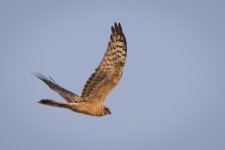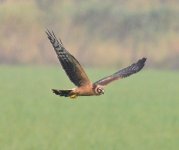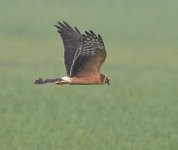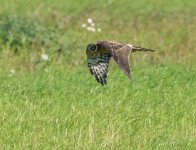-
Welcome to BirdForum, the internet's largest birding community with thousands of members from all over the world. The forums are dedicated to wild birds, birding, binoculars and equipment and all that goes with it.
Please register for an account to take part in the discussions in the forum, post your pictures in the gallery and more.
You are using an out of date browser. It may not display this or other websites correctly.
You should upgrade or use an alternative browser.
You should upgrade or use an alternative browser.
Harrier ID - Bulgaria (1 Viewer)
- Thread starter Yordan_13
- Start date
More options
Who Replied?Deb Burhinus
Used to be well known! 😎

My shout would be a female juvenile (fresh plumage, boldly barred primaries cf adult) Pallid but I am never sure about these young ringtails!
Face markings (restricted white around eyes), dusky secondaries with paler primaries, dark cheeks and distinct collar, dark eyes (F) etc all good Pallid features.
Face markings (restricted white around eyes), dusky secondaries with paler primaries, dark cheeks and distinct collar, dark eyes (F) etc all good Pallid features.
Last edited:
Deb Burhinus
Used to be well known! 😎

I understand this is only the case in ‘average’ individuals and subject to variation (and it is something I checked before answering because I also noted the wing formula in the OP)Long outermost primary (same length as P6
Forsman states :
”On average Pallids, the tip of p10 falls between p5 and p6, while on average Montagu’s it roughly equals the tip of p6, with age related variation”. (My emphasis)
The Raptors of Europe and The Middle East, Forsman D, 1999 p186.
The darkness of the primaries I would put largely down to the photograph - I suspect they are not ‘solid black’ - eg look how much shadow is on the face.
Juveniles have heavier barred primaries than adults anyway, in addition the barring at the middle lengths of the primaries looks thicker to me than the barring at the distal end, a Pallid feature.
I still think more features point to female Pallid than Montagu’s including the face pattern, although not bold, which, in addition to earlier comments, shows an equal width buff collar extending to the nape running under the dark cheek patch - (not shown by a female Monty’s afaia?)
Last edited:
Andy Adcock
Worst person on Birdforum

Ditto, thought the same but Collins states Monty's to have a 'dark frame to the hand' which this has not whilst whilst Pallid should show a 'rather pale edge' which this does have.Surely this is a Montagu's Harrier?
Long outermost primary (same length as P6), solid black 'fingers' and the neat, regular barring on the primaries (lacking the bold median bar on inner primaries of Pallid) point in that direction, as does the plain head/neck pattern.
This is a confusing bird because it's also showing the dark, primary tips of a juv Monty's.
Regarding sex, can they be done as juveniles?
Last edited:
Deb Burhinus
Used to be well known! 😎

Perhaps you could explain why KC please and how you are ruling out Pallid here.I’ll go with Montagu Harrier as well.
These are notoriously difficult to separate and I would expect people would need at least some experience of the variability in the field to separate these ‘ambiguous’ individuals with any degree of certainty.
Andy Adcock
Worst person on Birdforum

Who'll be brave enough to suggest hybrid?
Deb Burhinus
Used to be well known! 😎

I’m happy to have a debate and discussion because these ringtails are difficult but not if it is going to be a voting session ☹️
Andy Adcock
Worst person on Birdforum

kuzeycem
Medicinal Birding

I don't see much to suggest Pallid here. Dark fingers, dark trailing edge, barring all the way to the base of the primaries (no pale boomerang), diffuse head pattern, no neck collar etc. look better for Montagu's. Also, at least one moulted GC seems to show a bold barred pattern.
Deb Burhinus
Used to be well known! 😎

I don't see much to suggest Pallid here. Dark fingers, dark trailing edge, barring all the way to the base of the primaries (no pale boomerang), diffuse head pattern, no neck collar etc. look better for Montagu's. Also, at least one moulted GC seems to show a bold barred pattern.
Just a couple of points for clarification please because some of the features you mention overlap and perhaps you were not aware of that?
- You say the primaries are barred all the way to the base - juvenile female Pallids can show this and when primaries are barred throughout then the barring is bolder than in Montagu’s (Forsman 1999 p221) - the barring on juvenile female Montagu’s are typically of regular width and unbroken. With the hand swept back it is hard to make out the pattern of barring on the outer primaries but it looks irregular and broken to me at the base of the feathers and with the crossbars uneven near the distal end of the feather. A better view of an open hand would be helpful here imo.
- Juvenile female Pallids can show a dusky trailing edge to the inner primaries. See plates 426, 425 and 434 Flight Identification of Raptors , Forsman D, 2016 pp249-51
- The ‘pale boomerang’ is a variable feature not present in all Pallids.
- The head pattern of juvenile female Montagu’s are typically much more contrasty than equivalent Pallid due to the amount of white on the lores and above the ear coverts. While the head pattern isn’t typical for Pallid it’s not so typical for a juvenile Monty’s either imo
- I see do see a distinct buff collar surrounding the head and extending to the nape with a comparatively large dark cheek patch extending to the lower mandible. While Monty’s can show a buff collar it is not nearly as distinct or as wide and extensive as a juvenile Pallid. (See Forsman 1999 p218.)
- The secondaries look fine for juvenile Pallid imo (as per Forsman 1999 p221 ‘Secondaries often more distinctly barred than in juvenile Montagu’s, with one pale bar close to the trailing edge of the wing’)
- It also looks to me that it has quite a solid covert patch on the upperwing (although admittedly that is some auto-complete thinking) but if so that would point to Pallid.
Here is a juv. Montagu's Harrier (photographed in Belgium) compared to the subject bird:
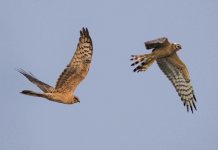
And here is a colour-ringed, recently fledged Montagu's (born in the Netherlands) with distinct buff collar up to nape, extensive dark head pattern, rather pale secondaries, bold, broken dark barring on primaries etc:
https://waarneming.nl/photos/17912213/

And here is a colour-ringed, recently fledged Montagu's (born in the Netherlands) with distinct buff collar up to nape, extensive dark head pattern, rather pale secondaries, bold, broken dark barring on primaries etc:
https://waarneming.nl/photos/17912213/
Last edited:
Alexander Stöhr
Well-known member
Hello,
so far thanks from me to all. When I first saw this picture, I couldnt identify it, as for example I have never seen a 1 cy Montagus with such a uniform head before (I have seen one yet unidentified bird this year, I will dig it out). Despite having seen quite a few of them among Europe, it is clear that that I neeed to learn here.
And although this is a very educational thread for me, I still hope for more comments and additional features/points. What an interesting bird with white areas on face buffish-orange and what helpfull comments. Thanks to all!
so far thanks from me to all. When I first saw this picture, I couldnt identify it, as for example I have never seen a 1 cy Montagus with such a uniform head before (I have seen one yet unidentified bird this year, I will dig it out). Despite having seen quite a few of them among Europe, it is clear that that I neeed to learn here.
And although this is a very educational thread for me, I still hope for more comments and additional features/points. What an interesting bird with white areas on face buffish-orange and what helpfull comments. Thanks to all!
Deb Burhinus
Used to be well known! 😎

Nice montage Smiths with the OP on the left - I was just thinking gameover, that looks spot on for the OP bird then realised it was the OP bird! 🙂
The juvenile Monty’s on the right shows a fairly typical face pattern does it not, with extensive white especially through the malar region extending to under the throat? The dark cheek patch looks comparatively narrow to me and only reaches to the gape, as it should in Monty’s and not the lower mandible as in a typical Pallid and as our OP.
This extensive collar is also consistent with juvenile Monty individuals that show more extensive white on their face, including the loral area, which seems more common in juvenile males - whereas Monty’s with the more darker faces generally completely lack the pale collar so again a variable feature in both species. (2cy Monty’s females I think also can sport quite a distinct buff collar).
I wonder if the Monty’s in the montage on the left is actually a juvenile male? There looks to be subtle structural differences with the OP having a slightly broader hand and looking marginally more bulky - it’s difficult to judge comparative size because it’s a montage - we know the OP is a female so perhaps it’s down to sexual dimorphism rather than speciation.
The newly fledged Monty’s in the waarneming link looks like it would be a much more challenging proposition if it were not ringed!
Anyway, happy to let it go at a Montagu’s if that’s what you say it is (I know protracted arguments aren’t your favourite passtime 😉) and I think there are rather too many variable and ambiguous ID features separating Pallid and Montagu’s ringtails for me to be certain of anything here 👍
The juvenile Monty’s on the right shows a fairly typical face pattern does it not, with extensive white especially through the malar region extending to under the throat? The dark cheek patch looks comparatively narrow to me and only reaches to the gape, as it should in Monty’s and not the lower mandible as in a typical Pallid and as our OP.
This extensive collar is also consistent with juvenile Monty individuals that show more extensive white on their face, including the loral area, which seems more common in juvenile males - whereas Monty’s with the more darker faces generally completely lack the pale collar so again a variable feature in both species. (2cy Monty’s females I think also can sport quite a distinct buff collar).
I wonder if the Monty’s in the montage on the left is actually a juvenile male? There looks to be subtle structural differences with the OP having a slightly broader hand and looking marginally more bulky - it’s difficult to judge comparative size because it’s a montage - we know the OP is a female so perhaps it’s down to sexual dimorphism rather than speciation.
The newly fledged Monty’s in the waarneming link looks like it would be a much more challenging proposition if it were not ringed!
Anyway, happy to let it go at a Montagu’s if that’s what you say it is (I know protracted arguments aren’t your favourite passtime 😉) and I think there are rather too many variable and ambiguous ID features separating Pallid and Montagu’s ringtails for me to be certain of anything here 👍
I would agree with smiths and Kuzey that this is a juvenile Montagu's.
First of all I think warm light is perhaps responsible for making the head and underparts look plainer and more uniform than they really are.
I would go for Monty's for the following reasons:
1. dark tips to outer primaries (there is barring on them but bars are quite broad and spaced quite far apart)
2. dark tips to inner primaries (backlighting making these look more diffuse than they really are)
3. lack of a "boomerang" at the base of the primaries
4. typical pattern on secondaries with dark tips, well-defined pale bar in midsection and dark bases)
5. vertical dark band on cheek less extensive (doesn't extend as far up the head)
6. collar concolorous with underparts
I also think the date is a little early for Pallid, which doesn't breed in Bulgaria and in my experience comes through in September. I have a feeling they're seen mostly along the Black Sea coast. I've seen at least one male from our house, which is close to the coast, around that time, although the ringtails I've also seen I have to let go as they're usually far too distant to identify.
First of all I think warm light is perhaps responsible for making the head and underparts look plainer and more uniform than they really are.
I would go for Monty's for the following reasons:
1. dark tips to outer primaries (there is barring on them but bars are quite broad and spaced quite far apart)
2. dark tips to inner primaries (backlighting making these look more diffuse than they really are)
3. lack of a "boomerang" at the base of the primaries
4. typical pattern on secondaries with dark tips, well-defined pale bar in midsection and dark bases)
5. vertical dark band on cheek less extensive (doesn't extend as far up the head)
6. collar concolorous with underparts
I also think the date is a little early for Pallid, which doesn't breed in Bulgaria and in my experience comes through in September. I have a feeling they're seen mostly along the Black Sea coast. I've seen at least one male from our house, which is close to the coast, around that time, although the ringtails I've also seen I have to let go as they're usually far too distant to identify.

More detailed opinion from my side
- finger barring and boomerang: much variable and overlap, here looks better for Monty
- inner primaries: quite reliable, I don't thin this is a trick of light and imho the tips of inner primaries are clearly diluted (but then the whole bird looks diluted)
- secondaries: big overlap, looks better for Pallid as Montys often much darker (again the bird looks diluted)
- most reliable is head pattern: does not look good for classical Pallid (collar diluted, cheek and boa diluted) but white around eye much better better for Pallid and way off for Monty
Andy Adcock
Worst person on Birdforum

I, slightly 'tongue in cheek', raised the hybrid issue, is that a possibility?More detailed opinion from my side
ID: diluted juvenile Ringtail Harrier with some Pallid features
- finger barring and boomerang: much variable and overlap, here looks better for Monty
- inner primaries: quite reliable, I don't thin this is a trick of light and imho the tips of inner primaries are clearly diluted (but then the whole bird looks diluted)
- secondaries: big overlap, looks better for Pallid as Montys often much darker (again the bird looks diluted)
- most reliable is head pattern: does not look good for classical Pallid (collar diluted, cheek and boa diluted) but white around eye much better better for Pallid and way off for Monty
Deb Burhinus
Used to be well known! 😎

Clearly there’s a contradiction in what we are seeing here! 🙂1. dark tips to outer primaries (there is barring on them but bars are quite broad and spaced quite far apart)
2. dark tips to inner primaries (backlighting making these look more diffuse than they really are)
3. lack of a "boomerang" at the base of the primaries
4. typical pattern on secondaries with dark tips, well-defined pale bar in midsection and dark bases)
Andy, I addressed points 1, 3, and 4, in my post above and the one before that. I think the overlap of features here are being underestimated a little bit imo. The presence or not of a ‘boomerang’ is variable (Forsman) as is what is regarded as optimum wing formula. The head pattern, as I said is not typical Pallid but is certainly off for Monty’s, the secondaries are perfectly fine for Pallid (if not better) which leaves the all important primaries - on one image such as this, where the contrast/natural lighting levels and swept back primary tips all conspire to make the barring pattern and extent of black on the tips difficult to judge, I would be careful relying on photo impression - female juvenile Pallids do have black tips to the primaries albeit not as extensive as Monty’s.
I would conclude with Tom that this is a ringtail with some Pallid features and I would personally leave it at that however, other people may have different experiences of these species which may prove more valuable than mine and work for them to come to more definitive conclusions 🤗
Last edited:
Users who are viewing this thread
Total: 2 (members: 0, guests: 2)




